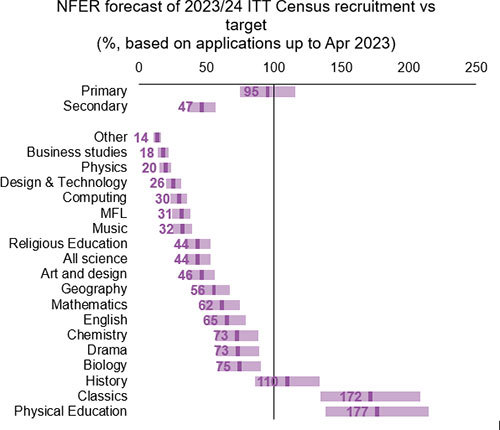New DfE ITT figures show cause for concern
Friday 28 April 2023
 This blog post was first published in Tes on Thursday 27 April 2023.
This blog post was first published in Tes on Thursday 27 April 2023.
Last month, NFER published its annual report on the state of teacher recruitment and retention in England, highlighting how the teacher supply challenge has intensified significantly since the pandemic. In the report we showed that, following historically low ITT recruitment in 2022/23, recruitment was showing no signs of improvement this year.
ITT recruitment is likely to fall significantly short of this year’s recruitment targets
The Department for Education (DfE) published ITT application figures for April earlier this week, and yesterday it released its recruitment targets for 2023/24. The latter represents the number of teachers it estimates need to enter teacher training in each subject this year to maintain existing staffing levels in schools. The most recent data on recruitment suggests that recruitment of primary teachers this year is likely to come close to its target. However, overall secondary recruitment is on track to meet less than half of its 2023/24 target, with all subjects but three likely to miss the mark.

Source: NFER analysis of DfE Apply and ITT Census data.
Note: Forecasts represent the central estimate, with the shaded bands showing the 95 per cent confidence interval on the prediction.
Continued under-recruitment of teachers this year is likely to further ratchet up the pressure on teacher supply in England, particularly for secondary schools. On top of the existing staffing and budget pressures that many schools are currently facing, it may become increasingly difficult to fill teaching vacancies with quality teachers. This is likely to have detrimental impacts on pupil attainment, particularly for schools in deprived areas (Worth and Faulkner-Ellis, 2022).
Falling interest in teaching has been accompanied by a greater need for teachers
This year’s forecasted under-recruitment is driven both by sluggish recruitment and significant changes in recruitment targets. Figures for April show that recruitment for some secondary subjects (such as physics, biology, computing, and modern foreign languages) is slightly higher this year than at the same point last year – likely due in part to increases in the generosity of training bursaries for these subjects. However, this has been offset by lower numbers of placed applicants in other subjects, meaning overall secondary ITT recruitment this year is no better than last year.
At the same time, yesterday’s publication of the 2023/24 recruitment targets affirms that the number of secondary teachers the Government estimates it needs to recruit this year has increased since last year, and far exceeds the number currently being recruited.
Indeed, recruitment targets this year are higher than last year for all but three secondary subjects. Targets for both maths and English have increased by 45 per cent since last year, but both are on track to recruit less than two-thirds of their respective target this year. Similarly, the target for physics increased by eight per cent over last year, while recruitment this year is likely to meet only a fifth of this target.
Targets for a number of subjects this year have increased due to past under-recruitment. From 2021/22, the DfE changed how it calculates ITT targets, and one element of this change is that, all else equal, recruitment targets have increased for subjects which have consistently under-recruited in previous years.
Similarly, secondary subjects which have generally tended to recruit well in previous years have had their targets reduced, including classics, history and physical education. Recruitment for all three of these subjects is on track to exceed their target this year.
The target for primary teacher recruitment in 2023/24 has also decreased since last year, by 21 per cent, which the DfE notes is due in part to a fall in primary-age pupil numbers. However, recruitment to primary ITT has slowed significantly over the last few months – the number of applicants placed on primary ITT courses in April 2023 is now 19 per cent lower than at the same point last year. A substantially lower target this year means that despite significantly slower recruitment, primary is on track to meet about 95 per cent of its recruitment target this year.
Given the substantial changes in ITT recruitment targets this year compared to last, it is helpful that yesterday, for the first time, the DfE also released more detail on how the targets are estimated. This should help provide the much-needed transparency on the target-setting process for stakeholders in the sector, which we have been calling for.
Policy action is urgently needed to address the challenge
The latest ITT recruitment data shows that the scale of the recruitment challenge continues to grow this year. Indeed, teacher supply has recently been gaining attention as a national issue – last month the Education Select Committee opened an inquiry into teacher recruitment, training, and retention, to which NFER has provided evidence.
However, the scale of the challenge necessitates significant and immediate policy action aimed at improving teacher’s pay and working conditions. Ensuring that teaching remains an attractive option when compared to other careers is key to ensuring a sustainable and sufficient supply of teachers entering the system for future years.
